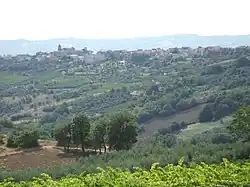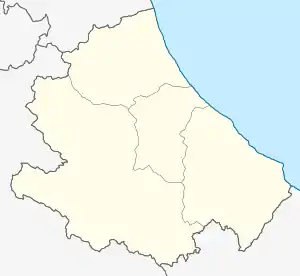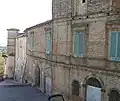Scerni | |
|---|---|
| Comune di Scerni | |
 A panorama of Scerni | |
Location of Scerni | |
 Scerni Location of Scerni in Italy  Scerni Scerni (Abruzzo) | |
| Coordinates: 42°7′N 14°34′E / 42.117°N 14.567°E | |
| Country | Italy |
| Region | Abruzzo |
| Province | Chieti (CH) |
| Frazioni | Annunziata, Bardella, Caltrucci, Cerase, Colle Marrollo, Colle Orzo, Fontenuova, Piano dei Fiori, Ragna, San Giacomo, Torrone, Tratturo |
| Area | |
| • Total | 41.05 km2 (15.85 sq mi) |
| Elevation | 281 m (922 ft) |
| Population (2008)[2] | |
| • Total | 3,578 |
| • Density | 87/km2 (230/sq mi) |
| Demonym | Scernesi |
| Time zone | UTC+1 (CET) |
| • Summer (DST) | UTC+2 (CEST) |
| Postal code | 66020 |
| Dialing code | 0873 |
| ISTAT code | 069087 |
| Patron saint | San Panfilo |
| Saint day | 28 April |
| Website | Official website |
Scerni (Abruzzese: Scìrne) is a town of 3,645 inhabitants of the province of Chieti is part of the Middle Vastese. Total area is 41 square kilometres (16 sq mi), and population density is 89 inhab/km2. The county has borders with Atessa, Gissi, Monteodorisio and Pollutri.
Scerni was once part of the Kingdom of Two Sicilies.
Climate
Based on data from the years 1961 to 1990, the average temperature of the coolest month January, is about 6 °C (43 °F), and that of the warmest month August, is about 24 °C (75 °F).[3]
| Scerni | ||||||||||||||||||||||||||||||||||||||||||||||||||||||||||||
|---|---|---|---|---|---|---|---|---|---|---|---|---|---|---|---|---|---|---|---|---|---|---|---|---|---|---|---|---|---|---|---|---|---|---|---|---|---|---|---|---|---|---|---|---|---|---|---|---|---|---|---|---|---|---|---|---|---|---|---|---|
| Climate chart (explanation) | ||||||||||||||||||||||||||||||||||||||||||||||||||||||||||||
| ||||||||||||||||||||||||||||||||||||||||||||||||||||||||||||
| ||||||||||||||||||||||||||||||||||||||||||||||||||||||||||||
Description
The town is attractive, amid gentle hills and with a mild climate. It is distinguished by the production of olive oil, wine and sausages (the speciality is the Ventricina variety).
History
The origins of Scerni are lost in the mists of time. The only certainty is that the site where the village stands now was inhabited in prehistoric and ancient Roman times. In the medieval ages, several castles and fortifications were built in and around the city.
At the time of the French Revolution, the Baron De Riseis sided with the people of the country with Giuseppe Proni from Introdacqua, former cleric of the Marquis of Vasto, against the invasion of the Jacobins[4]
On 25, 26 and 27 February 1860 more than a thousand peasants armed with clubs and halberds invaded the estate of the Marquis D'Avalos, destroying a rural house, stealing firewood and beating up the forest guards. The peasant fury and its numerical superiority defeated the police and the urban guards of Pollutri and Monteodorisio. It was a real uproar led with firearms in hand, led by Michelangelo Tarquinio, Giuseppe "Passaguai" Menna and Luigi Berarducci.[5]
Places
The patron saint of Scerni is San Panfilo (Saint Pamphilus of Sulmona). There is a church consecrated to him. Other attractions are the Palazzo De Riseis.
 Lateral facade of the Church of San Panfilo, Scerni, Italy
Lateral facade of the Church of San Panfilo, Scerni, Italy Palazzo De Riseis, Scerni, Italy
Palazzo De Riseis, Scerni, Italy
Distinguished citizens
- Giuseppe De Riseis, (Scerni, Chieti, 1833 - Rome, 1924), politician.
- Leonardo Umile (Scerni, 1919 - to Bastia Nardi Licciana, 1944) partisan.
See also
Notes
- ↑ "Superficie di Comuni Province e Regioni italiane al 9 ottobre 2011". Italian National Institute of Statistics. Retrieved 16 March 2019.
- ↑ All demographics and other statistics from the Italian statistical institute (Istat)
- ↑ Tabella climatica Scerni, Italia
- ↑ Massimo Viglione, The Italian Vendée, Effedieffe (1995), pp. 151
- ↑ Fulvio D'Amore, Viva Francesco II! Morte a Vittorio Emanuele! Controcorrente (a. 2006), pp. 93
External links
- Official website of the municipality (in Italian)
- webcam on Scerni (in Italian)
- Pro Loco Scerni on Facebook (in Italian)
- Comune di Scerni on Facebook (in Italian)